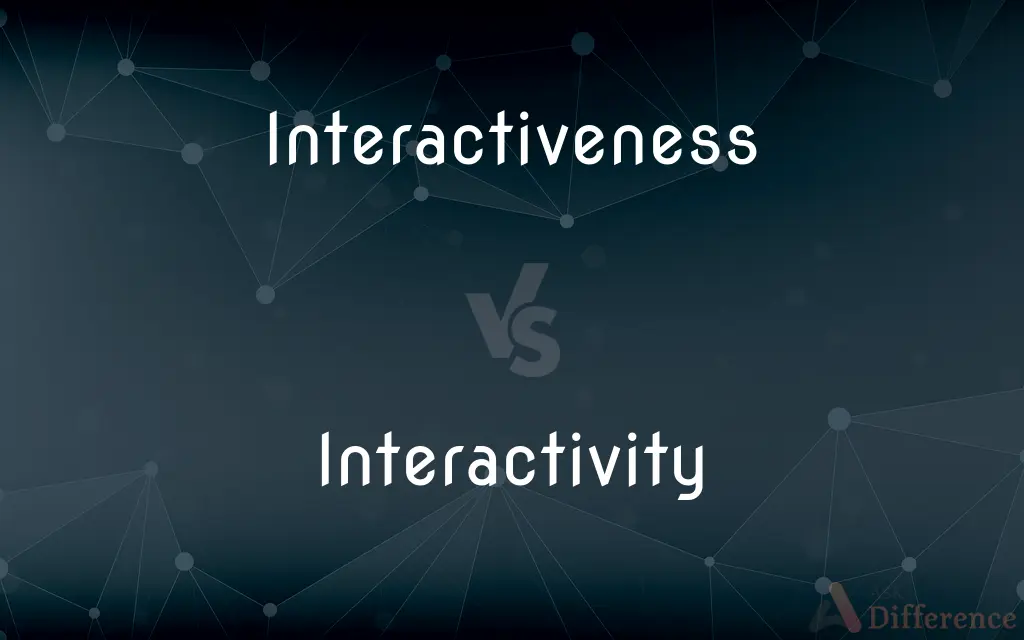Interactiveness vs. Interactivity — What's the Difference?
By Urooj Arif & Maham Liaqat — Updated on March 31, 2024
Interactiveness emphasizes the quality of engaging or involving users, while interactivity focuses on the capability of a system to respond to user inputs.

Difference Between Interactiveness and Interactivity
Table of Contents
ADVERTISEMENT
Key Differences
Interactiveness refers to the degree to which something encourages or necessitates engagement or participation from a user or audience. It often emphasizes the active role of the user in the process. On the other hand, interactivity is a characteristic of a system, media, or application that allows for and supports interaction between users and the system itself. It's a measure of how well the system responds to user inputs, facilitating a two-way communication.
While interactiveness can be observed in both digital and non-digital contexts, such as interactive art installations or educational activities that require physical participation, interactivity is commonly associated with digital technologies. These technologies are designed to respond dynamically to user inputs, ranging from simple commands to complex interactions. This distinction highlights how interactiveness can be broader, encompassing any form of engagement, whereas interactivity is more specific to the technical capabilities that enable such engagement.
Interactiveness often depends on the design and implementation of the interaction opportunities within an environment or platform. It is about creating an engaging experience that encourages participation. Whereas, interactivity involves the technical mechanisms and features that allow for this engagement to happen. This includes software, hardware, and user interface design that enable interactive experiences.
The level of interactiveness can influence the effectiveness of educational tools, marketing strategies, or entertainment experiences, as it directly impacts user engagement and satisfaction. Meanwhile, the level of interactivity determines the flexibility and responsiveness of a system, affecting how intuitively and effectively users can navigate and utilize it.
Interactiveness and interactivity both play crucial roles in the design of user experiences but focus on different aspects of the interaction. Interactiveness is about the extent and quality of engagement, aiming to captivate and involve the audience. Interactivity, however, provides the means and capacity for this engagement, focusing on the functional interaction between the user and the system.
ADVERTISEMENT
Comparison Chart
Definition
The quality of involving or engaging a user or audience
The capability of a system to respond to user inputs
Context
Can be both digital and non-digital
Primarily associated with digital technologies
Focus
On encouraging participation and engagement
On enabling and supporting interaction through technical means
Impact
Influences user engagement and satisfaction
Determines system's responsiveness and flexibility
Key Considerations
Design and implementation of engaging experiences
Technical mechanisms, software, hardware, and user interface design for interaction
Compare with Definitions
Interactiveness
Applies to both digital and physical realms.
The classroom's interactiveness was enhanced by incorporating interactive quizzes and group projects.
Interactivity
Refers to technical aspects that enable interaction.
The software's interactivity is facilitated through an intuitive user interface and responsive design.
Interactiveness
The quality or condition of being interactive.
The exhibit's interactiveness drew in large crowds, engaging them with hands-on activities.
Interactivity
The capability of a computer system, software, or device to interact with a user.
The game's interactivity was highly praised, with players enjoying various interactive features.
Interactiveness
A key factor in creating engaging experiences.
The designer focused on increasing the interactiveness of the website to improve user engagement.
Interactivity
Primarily associated with digital and electronic media.
The website's interactivity includes form submissions, live chat, and user-generated content.
Interactiveness
Refers to the extent to which engagement is encouraged or facilitated.
The seminar's interactiveness was evident in the lively discussions and participatory exercises.
Interactivity
Focuses on the system's ability to respond to inputs.
Enhancements in the platform's interactivity have significantly improved user experience.
Interactiveness
Emphasizes the user's active role in the interaction.
The application's interactiveness made it popular among users who prefer engaging content.
Interactivity
Concerns the implementation of interactive functionalities.
Developers are adding more interactivity to the application, including touch gestures and voice commands.
Interactiveness
Interactivity
Interactivity
Across the many fields concerned with interactivity, including information science, computer science, human-computer interaction, communication, and industrial design, there is little agreement over the meaning of the term "interactivity", but most definitions are related to interaction between users and computers and other machines through a user interface. Interactivity can however also refer to interaction between people.
Interactivity
The process of two people or things working together and influencing each other
Distance learning systems with high levels of interactivity with the teacher
Improved interactivity between companies
Interactivity
The quality of being interactive.
Common Curiosities
What is interactivity?
Interactivity refers to the ability of a system to respond to user inputs, enabling a two-way communication.
Can interactivity exist without high interactiveness?
Yes, a system can have technical interactivity without necessarily engaging users deeply, depending on how the interactive features are implemented and presented.
How do interactiveness and interactivity affect user experience?
Both influence user experience by determining the level of engagement and the ease of interaction, impacting satisfaction and effectiveness.
What role does user interface play in interactivity?
The user interface plays a central role in interactivity by facilitating the ease and effectiveness of user-system interactions.
How does interactiveness apply in non-digital contexts?
In non-digital contexts, interactiveness can be seen in activities or environments that encourage physical participation, such as interactive workshops or art installations.
How can interactiveness be measured?
Interactiveness can be measured by user engagement levels, participation rates, and the diversity of interaction opportunities.
What impacts the level of a website's interactivity?
A website's interactivity level is impacted by its features like live chat, interactive media, and user input forms.
How do interactivity and interactiveness relate to gamification?
In gamification, both interactivity and interactiveness are key for engaging users in game-like activities, enhancing motivation and participation.
Are interactiveness and interactivity important in educational tools?
Yes, they are crucial in educational tools for enhancing learning experiences through engagement and interactive feedback.
What is interactiveness?
Interactiveness is the quality of engaging or involving a user or audience in active participation.
How do designers increase a product's interactiveness?
Designers can increase a product's interactiveness by incorporating features that encourage user participation and feedback.
Is interactivity limited to digital products?
While commonly associated with digital products, interactivity can also apply to physical systems that respond to user inputs.
Can a physical product be interactive?
Physical products can be interactive if they include elements that respond to user actions, such as buttons or sensors.
Why is feedback important in interactivity?
Feedback is crucial in interactivity as it informs users about the outcomes of their actions, making interactions meaningful and guiding further engagement.
Can interactivity improve learning outcomes?
Yes, interactivity can improve learning outcomes by making educational content more engaging and responsive to student needs.
Share Your Discovery

Previous Comparison
Sufficiency vs. Efficiency
Next Comparison
Enable vs. AbleAuthor Spotlight
Written by
Urooj ArifUrooj is a skilled content writer at Ask Difference, known for her exceptional ability to simplify complex topics into engaging and informative content. With a passion for research and a flair for clear, concise writing, she consistently delivers articles that resonate with our diverse audience.
Co-written by
Maham Liaqat













































